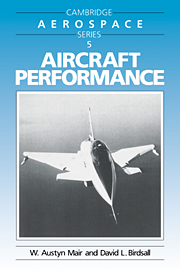Book contents
- Frontmatter
- Contents
- Preface
- Introduction
- 1 Aerodynamic foundations
- 2 Basic flight theory
- 3 Drag equations
- 4 Climbing performance
- 5 Power plants
- 6 Take-off and landing performance
- 7 Fuel consumption, range and endurance
- 8 Turning performance
- 9 Vectored thrust
- 10 Transonic and supersonic flight
- Appendixes
- References
- Index
10 - Transonic and supersonic flight
Published online by Cambridge University Press: 02 December 2009
- Frontmatter
- Contents
- Preface
- Introduction
- 1 Aerodynamic foundations
- 2 Basic flight theory
- 3 Drag equations
- 4 Climbing performance
- 5 Power plants
- 6 Take-off and landing performance
- 7 Fuel consumption, range and endurance
- 8 Turning performance
- 9 Vectored thrust
- 10 Transonic and supersonic flight
- Appendixes
- References
- Index
Summary
On an aircraft in supersonic flight shock waves are always present, extending to a great distance from the aircraft. As mentioned in §3.1.2 they are the cause of an additional component of drag, the wave drag, which has been neglected in the preceding chapters but which must be considered in transonic and supersonic flight as an important component of the total drag. The coefficient of wave drag of an aircraft depends on the lift coefficient and on the Mach number M and hence, with this component of drag included, the drag polar relating CD to CL now depends on M. The drag polar may still be represented approximately by the simple parabolic drag law as given by Equation (3.6) but now the coefficients K1 and K2 are functions of Mach number.
In the preceding chapters where wave drag was neglected, a curve relating β to Ve, as in Figure 2.9, could be applied to all heights, for a given aircraft weight, but with wave drag included this is no longer valid, because for any given value of Ve the Mach number varies with height. Thus no simplification can be obtained by the use of Ve, rather than V or M, and consequently the use of Ve* and the speed ratio ν is no longer helpful in the calculation of performance. In contrast, the quantity (ƒ − β) is still of prime importance in determining rate of climb and acceleration, as it is at lower speeds, and in general this quantity must be calculated for each combination of speed and height.
- Type
- Chapter
- Information
- Aircraft Performance , pp. 252 - 282Publisher: Cambridge University PressPrint publication year: 1992



